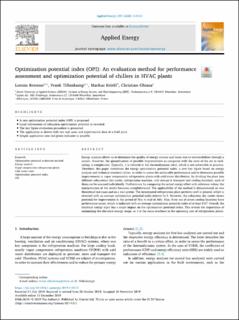Please use this identifier to cite or link to this item:
https://doi.org/10.21256/zhaw-19187Full metadata record
| DC Field | Value | Language |
|---|---|---|
| dc.contributor.author | Brenner, Lorenz | - |
| dc.contributor.author | Tillenkamp, Frank | - |
| dc.contributor.author | Krütli, Markus | - |
| dc.contributor.author | Ghiaus, Christian | - |
| dc.date.accessioned | 2020-01-23T15:46:58Z | - |
| dc.date.available | 2020-01-23T15:46:58Z | - |
| dc.date.issued | 2020-02-01 | - |
| dc.identifier.issn | 0306-2619 | de_CH |
| dc.identifier.uri | https://digitalcollection.zhaw.ch/handle/11475/19187 | - |
| dc.description.abstract | Exergy analysis allows us to determine the quality of energy sources and losses due to irreversibilities through a system. However, the quantification of possible improvements as compared with the state of the art in technology is complicated. Typically, it is referred to the thermodynamic ideal, which is not achievable in practice. Therefore, this paper introduces the exergy optimization potential index, a new key figure based on exergy analysis and technical standard values, in order to assess the achievable performance and to determine possible improvements in vapor compression refrigeration plants with cold water distribution. By dividing the plant into different subsystems (dry cooler, refrigeration machine, cold storage & transport and cooling location), each of them can be assessed individually. Furthermore, by comparing the actual exergy effort with reference values, the interpretation of the results becomes straightforward. The applicability of the method is demonstrated on two theoretical test cases and on a real system. The investigated refrigeration plant performs well in general, which is revealed with an average optimization potential index inferior to 0. However, the subsystem dry cooler shows potential for improvement in the period of May to mid of July. Also, three out of seven cooling locations have performance issues, which is indicated with an average optimization potential index of at least 0.07. Overall, the electrical exergy input has a major impact on the optimization potential index. This reveals the importance of minimizing the electrical energy usage, as it is the main overhead in the operating cost of refrigeration plants. | de_CH |
| dc.language.iso | en | de_CH |
| dc.publisher | Elsevier | de_CH |
| dc.relation.ispartof | Applied Energy | de_CH |
| dc.rights | http://creativecommons.org/licenses/by/4.0/ | de_CH |
| dc.subject | Optimization potential evaluation method | de_CH |
| dc.subject | Exergy analysis | de_CH |
| dc.subject | Vapor compression refrigeration plants | de_CH |
| dc.subject | Cold water units | de_CH |
| dc.subject | Optimization potential index | de_CH |
| dc.subject | OPI | de_CH |
| dc.subject.ddc | 621.04: Energietechnik | de_CH |
| dc.title | Optimization potential index (OPI): an evaluation method for performance assessment and optimization potential of chillers in HVAC plants | de_CH |
| dc.type | Beitrag in wissenschaftlicher Zeitschrift | de_CH |
| dcterms.type | Text | de_CH |
| zhaw.departement | School of Engineering | de_CH |
| zhaw.organisationalunit | Institut für Energiesysteme und Fluid-Engineering (IEFE) | de_CH |
| dc.identifier.doi | 10.1016/j.apenergy.2019.114111 | de_CH |
| dc.identifier.doi | 10.21256/zhaw-19187 | - |
| zhaw.funding.eu | No | de_CH |
| zhaw.issue | 114111 | de_CH |
| zhaw.originated.zhaw | Yes | de_CH |
| zhaw.publication.status | publishedVersion | de_CH |
| zhaw.volume | 259 | de_CH |
| zhaw.publication.review | Peer review (Publikation) | de_CH |
| zhaw.author.additional | No | de_CH |
| Appears in collections: | Publikationen School of Engineering | |
Files in This Item:
| File | Description | Size | Format | |
|---|---|---|---|---|
| Brenner et al. - 2019 - Optimization potential index (OPI) An evaluation method for performance assessment and optimization potential of chillers in HVAC plants.pdf | Optimization potential index (OPI): An evaluation method for performance assessment and optimization potential of chillers in HVAC plants | 6.33 MB | Adobe PDF |  View/Open |
Show simple item record
Brenner, L., Tillenkamp, F., Krütli, M., & Ghiaus, C. (2020). Optimization potential index (OPI): an evaluation method for performance assessment and optimization potential of chillers in HVAC plants. Applied Energy, 259(114111). https://doi.org/10.1016/j.apenergy.2019.114111
Brenner, L. et al. (2020) ‘Optimization potential index (OPI): an evaluation method for performance assessment and optimization potential of chillers in HVAC plants’, Applied Energy, 259(114111). Available at: https://doi.org/10.1016/j.apenergy.2019.114111.
L. Brenner, F. Tillenkamp, M. Krütli, and C. Ghiaus, “Optimization potential index (OPI): an evaluation method for performance assessment and optimization potential of chillers in HVAC plants,” Applied Energy, vol. 259, no. 114111, Feb. 2020, doi: 10.1016/j.apenergy.2019.114111.
BRENNER, Lorenz, Frank TILLENKAMP, Markus KRÜTLI und Christian GHIAUS, 2020. Optimization potential index (OPI): an evaluation method for performance assessment and optimization potential of chillers in HVAC plants. Applied Energy. 1 Februar 2020. Bd. 259, Nr. 114111. DOI 10.1016/j.apenergy.2019.114111
Brenner, Lorenz, Frank Tillenkamp, Markus Krütli, and Christian Ghiaus. 2020. “Optimization Potential Index (OPI): An Evaluation Method for Performance Assessment and Optimization Potential of Chillers in HVAC Plants.” Applied Energy 259 (114111). https://doi.org/10.1016/j.apenergy.2019.114111.
Brenner, Lorenz, et al. “Optimization Potential Index (OPI): An Evaluation Method for Performance Assessment and Optimization Potential of Chillers in HVAC Plants.” Applied Energy, vol. 259, no. 114111, Feb. 2020, https://doi.org/10.1016/j.apenergy.2019.114111.
Items in DSpace are protected by copyright, with all rights reserved, unless otherwise indicated.